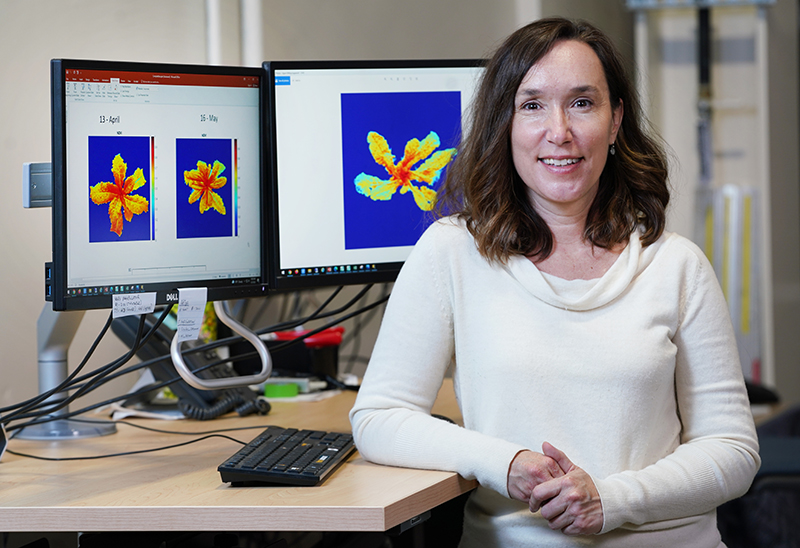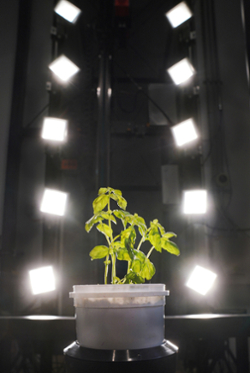Contaminated leafy greens turn purple
Some might say you look a little green when you are sick. Leafy greens actually turn purple — although not obvious to the human eye, it can be seen through advanced hyperspectral imaging (different than purple varieties of some vegetables). Purdue researchers discovered this color change in kale and basil stressed by cadmium, a heavy metal toxic to human and animal health.
The new detection method advances work to create a soil amendment that binds to the metal and keeps it from the plants, improving food safety in produce, baby food and prepared meals.
 Lori Hoagland, professor of horticulture and landscape architecture at Purdue University, used advanced hyperspectral imaging to detect toxic metal stress in basil and kale in her work to improve food safety. (Purdue University photo/Tom Campbell)
Lori Hoagland, professor of horticulture and landscape architecture at Purdue University, used advanced hyperspectral imaging to detect toxic metal stress in basil and kale in her work to improve food safety. (Purdue University photo/Tom Campbell) “It is very difficult to see heavy metal stress in plants,” said Lori Hoagland, professor of Horticulture and Landscape Architecture at Purdue University, who led the research. “We need new tools for it. If we can quickly see it and accurately measure it as the plants grow, we will be better able to develop soil amendments that sequester the harmful metals, as well as identify contamination before it reaches our plates. Our goal is to be able to have drones that fly over fields and detect plant stress from cadmium, lead and arsenic.”
Hyperspectral detection is much faster than traditional chemical analysis techniques. It also does not require destruction of the plant being analyzed, which enables studies of the plants and soil amendments through different stages of plant development.
“Cadmium contamination of plants is known as a ‘silent killer’ because we can’t see it and don’t typically test for it,” said Hoagland, who leads Purdue’s Soil Microbial Ecology Lab. “The plants do suffer when exposed to high levels of cadmium, but they don’t shrivel and wilt or die. They appear fine, unless the cadmium levels are through the roof. Contaminated plants make it through to maturity and harvesting.”
Cadmium is used in batteries and is often bound to phosphate mined for fertilizers. Throughout the world, it and other heavy metals from trash and pollution seep into the soil and travel to nearby farms where crops absorb them. Consuming high levels of cadmium can lead to kidney disease, bone problems, cancer and other health issues.
“It is naturally present in many vegetables in small concentrations, but elevated levels can be harmful,” she said. “We particularly need to keep these levels low in baby foods, but it is a growing issue throughout our food chain.”
Hoagland worked with a team at Purdue’s Ag Alumni Seed Phenotyping Facility to sort through thousands of different wavelengths to see what combinations showed changes that indicated plant stress from the metal. They then verified the method through chemical analysis techniques.
The phenotyping facility is equipped with a set of imaging-based, high-throughput plant phenotyping systems that aren’t found at many universities. A phenotype is an observable characteristic of an organism that results from its genetic code and its interactions with the environment. Researchers are only beginning to tap into its capabilities, Hoagland said.

“I went into the study as a bit of a test and unsure of whether or not it would work for my research,” she said. “I was surprised by how powerful a tool it can be and how much data it generates in a short period of time. These imaging techniques are going to help us learn and answer many scientific questions.”
In the controlled-environment phenotyping facility, plants travel by conveyor belt to an imaging station at intervals selected by the researchers. Hoagland’s team’s results showed kale accumulated higher levels of cadmium than basil under the same soil conditions, but symptoms of cadmium stress were stronger in basil. They also discovered that the plants only showed cadmium stress in early development.
“Hyperspectral imaging includes many more bands than the red, green, blue, or RGB, color bands we can see,” said Yang Yang, director of digital phenomics at Purdue. “The technology is very sensitive to changes within plants that are not detectable to our eyes.”
The team implemented a machine-learning algorithm to sort and classify the data.
“Through our dual pair of hyperspectral cameras, we can achieve full spectrum optical sensing from both the top and sides of a plant,” Yang said. “Purdue’s hyperspectral system can be used to scan plants from seedlings to a 15-foot corn stalk. This was the first time we used it to look for stress from heavy metals. It is an exciting application and was a new interdisciplinary challenge.”
The team first thought the effect of cadmium toxicity stress on levels of chlorophyll production would be a likely indicator, and they examined the green light spectrum. The resulting color change was very subtle. The team progressed through other stress-related changes in the plant and other parts in the plant’s reflectance spectra, Hoagland said. They found changes in metabolites due to the stress response offered a much clearer hyperspectral signal of stress.
“Looking at these secondary metabolites gave a much stronger signal, and there was a clear ‘purpling’ of the plant when viewed with the corresponding anthocyanin wavelengths,” she said. “So, if green decreases and purple increases, we know the plant is stressed.”
Hoagland and her team evaluated “vegetation indices,” which are combinations of reflectance from different wavelengths that have been identified as best for hyperspectral analysis of different plant properties. The team found the Anthocyanin Reflective Index, or ARI, is the best for detecting cadmium stress, and they developed a specific vegetation index ratio equation for it. They also developed a soil amendment to reduce the level of cadmium taken up by the plant. The work is detailed in a paper published in the journal Environmental Pollution.
“I have been developing soil amendments to help remedy environmental pollution,” Hoagland said. “These amendments are different mixes of bio char, which includes organic material waste and specially treated wood chips burnt at high temperatures. These can bind heavy metals and reduce uptake in combination with microbial processes. The trick is finding the right formulation of feedstock and temperatures.”
The tested formulation slightly decreased cadmium levels in the plants, she said. One solution could be for farmers to simply use more of the amendment, but Hoagland plans to continue to adjust and improve the formulation.
She also plans to use the hyperspectral imaging method to find a clear signal for lead and arsenic.
“I’m a soil microbiologist, so I’m usually in the dirt,” Hoagland said. “Imaging technology had been used more for evaluating drought responses or nutrients in plants, and my work was different. This was a new application for the tools and a great collaboration between engineers and scientists.”
In addition to Hoagland and Yang, Purdue researchers Maria Zea, a graduate student in Hoagland’s lab; Augusto Souza, a postdoctoral researcher for the phenotyping facilities; Linda Lee, professor of agronomy; and Krishna Nemali, controlled environment agriculture Extension specialist; worked on the project and are co-authors of the paper.






